
California wildfires have killed at least 42 people and destroyed thousands of homes and businesses, scorching more than 200,000 acres—roughly the size of New York City. The blazes are the deadliest since record keeping began. As global temperatures continue to rise, we’ll look at the link between fires and climate change with Max Moritz, fire research scientist based at UC Santa Barbara.
Transcript
AMY GOODMAN: Yes, this is Democracy Now!, democracynow.org, The War and Peace Report. I’m Amy Goodman. We’re broadcasting from the Community Media Center of Marin, the CMCM, in San Rafael, California, not far from the wildfires that have devastated Northern California, as we continue our conversation about the wildfires, the deadliest since records have began. Oh, 42 people have been killed. Destroying thousands of homes and businesses, the fire has, scorched more than 200,000 acres—roughly the size of New York City. Tens of thousands of evacuees have now been allowed to return to their homes, with about 15,000 still displaced as of Thursday. At least 100,000 people were forced to evacuate, with about 75,000 [sic] people still displaced. Some residents had to flee for their lives as drought conditions and powerful, erratic winds contributed to the explosive spread of the fires. This is Cal Fire Chief Ken Pimlott.
FIRE CHIEF KEN PIMLOTT: We are still impacted by five years of drought. With the significant rain that we had last winter, those effects are gone of that moisture, and we are literally looking at explosive vegetation. These fires are burning actively during the day and at night, when one would expect a fire to subside. And make no mistake: This is a serious, critical, catastrophic event.
AMY GOODMAN: Among the victims of the wildfires were elderly residents of Sonoma County, where authorities say their bodies were so charred, the only way to identify some of them was by the serial numbers on artificial joints or other medical devices. Now officials and residents are searching for answers about the causes of this fire, as well as others that have scorched California’s landscape over the past few decades. And while studies have linked wildfires to climate change, researchers say there are other contributing factors that should be considered.
For more, we’re joined from Santa Barbara, California, by Dr. Max Moritz, fire research scientist with the University of California Cooperative Extension, which is based at the University of California, Santa Barbara.
Dr. Max Moritz, welcome to Democracy Now! Can you talk about what has happened in Northern California and how it relates to climate change, to climate chaos, global warming?
MAX MORITZ: Sure. Thanks for the opportunity, Amy.
As you’ve noted, the fires are still not even out, so we have a lot to learn. But in general, what we do know is that these were wind-driven wildfires that swept off of vegetated landscapes and entered into urban areas and then transitioned to an urban conflagration. So, some aspects of why there were so many homes lost and so many fatalities are related to the vulnerabilities of this particular situation. And there are some—definitely some lessons there that we will be learning about that. And other aspects of it relate to the ferocity, the strength of the fires themselves, on the wildfires, as they progressed across the landscape. As Ken Pimlott noted, the effects of the drought in previous years in California—we had five years of very severe drought—there is a lingering effect of those, even though we had ample rainfall in much of the state last year. The drought itself was made worse, probably, by climate change, by heightened anthropogenic greenhouse gas-forced temperatures. They make the drought more severe. They basically increase evaporative demand on the plants. And basically, the water content of the plants themselves is more vulnerable under those conditions. And that is a greenhouse gas-related effect.
Lots of trends that we’ve seen over the last several decades in fire have been related back to climate change. There’s been some good work looking at the temperature effects, again, increasing evaporative demand, but also, say, warmer springs in higher elevations causing earlier snowmelt in snow-dominated forests and leading to a longer, more severe fire season. So there’s pretty conclusive evidence for a link to climate change for many of the fires that we’ve seen in the last couple of decades. And the trends match up with what we expect from climate change and from our models.
These particular events, because they were so wind-driven, it’s harder to make a link to climate change, although there are ways that you would link the drought severity and the—possibly the flame lengths and the rates of spread. While it was a wildfire, but, really, the losses that we saw in the urbanized environment, in terms of structure losses and lives, it’s really a different beast there. This is not a classic wildfire situation. This is really an urban conflagration.
AMY GOODMAN: And that issue of urban wildfires, of this urban conflagration, talk more about how unusual this is.
MAX MORITZ: Yeah. So, typically when we think about, you know, our fire problem, we’re thinking about fire on natural landscapes, whether they be forests or woodlands or grasslands or shrublands. And we sort of thought we solved the urban conflagration problem many years ago. Many cities, in the earlier centuries, were taken out by wildfire. And we—through building codes, we kind of thought we had solved some of that problem.
But increasingly in the last decade, we have seen the occasional fire sweep into an urbanized area—this is not the only example, but it’s clearly the most devastating. We’ve seen fires sweep into an urbanized area, and it manages to breach the boundary. We sometimes call this the wildland-urban interface, where naturally fire-prone landscapes abut developed neighborhoods. And we see that it’s possible, under extreme weather conditions, where we have hot, dry winds, that these fires can actually penetrate the boundary and then become an urban structure-to-structure conflagration. And so it’s a very different type of fire. And it’s not one that we tend to know a lot about, because they’re relatively rare. There have been instances, like I’ve said, and it appears that they’re becoming a little more common. So it’s clearly something that we need to plan for and learn from, so that we can do things differently in the future.
AMY GOODMAN: Dr. Max Moritz, your research suggests that we should learn to coexist with the fires. What exactly does that mean?
MAX MORITZ: Right. So, fire, historically—we have had a rocky relationship with fire. Historically, we depended on fire. We used it as a tool for landscape clearing. We used it—we’ve used it as a cooking tool forever. But as we’ve developed, we’ve sort of handed fire over to the professionals. And we are less and less comfortable with fire, and it’s more and more of a threat, when, if you look at it, there are plenty of other natural hazards that we treat quite differently. We tend to fight fire. And in between fires, we think of fighting the vegetation, in a sense.
But for lots of other natural hazards, we have a different view. We sort of accommodate them, and we treat them as inevitable. So, if we think about floods or landslides or earthquakes, tornadoes and hurricanes, we have a different approach to how we deal with those, and it often involves planning for them as inevitable, building them into our land-use planning and our building codes. We have maps that we use for these other natural hazards. And often we avoid the most hazardous part of the landscape, and we tend to try to concentrate development on the least hazardous parts of the landscape for other natural hazards.
But for fire, we tend not to do that, for a variety of reasons. And so, many of us have argued that it’s time to take a different view towards fire and try to coexist with it as a natural and inevitable process. And I think events like this show us just how important that is. Some of the lessons—
AMY GOODMAN: And what would you say—
MAX MORITZ: There’s probably going to be a few—
AMY GOODMAN: What would you say to the president of the United States, who is a climate change denier—
MAX MORITZ: Yeah.
AMY GOODMAN: —when it comes to the issue of these wild, urban fires and climate change?
MAX MORITZ: Well, I think the urban fire problem is one that has a separate set of causes and lessons that come from it. But the fire problem, in general, the trends that we’ve seen in increasing sizes and possibly intensities of fires throughout the West, there’s conclusive evidence for links to climate change. There are other factors that come into play, depending on where you’re talking about. There’s a legacy of fire suppression. And so, some places are probably burning more, or more intensely, because of that, that history of putting out fires. There are some other places that have invasive species—the Great Basin and cheatgrass—bringing fire into a place that didn’t have fire as often. And then humans developing the landscape and flooding it with ignitions at just the wrong times is another factor. But climate change is real. And amongst those of us studying it, modeling it, looking at the trends, we are confident that there’s good evidence to support that link.
And so, the president is really being very naïve, and the administration, by not recognizing this as real. And I think, worse than that, in the fire context, or on top of that, is that it appears that the administration’s—one of the administration’s key solutions to this would be to log our way out of the problem. And very few people studying fire or forest management, very few of us doing research in this area, believe that timber harvesting, which has a certain set of goals and methods, that that equates to fire hazard reduction. There’s very big differences between the way you would go about managing an ecosystem for fire hazard reduction and commercial timber harvest. So this idea that we can, through logging, somehow address our fire problem, is very backwards and very outdated.
AMY GOODMAN: Dr. Max Moritz, I want to thank you so much for being with us, fire research scientist with the University of California Cooperative Extension. He’s based at University of California, Santa Barbara. We’re north; we’re in Marin County. We’re near the fires in Northern California.
When we come back, we’ll talk with environmental leaders about what to do about climate change and where they’re focusing their organizations. Stay with us.

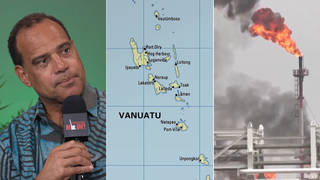
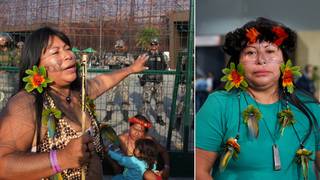
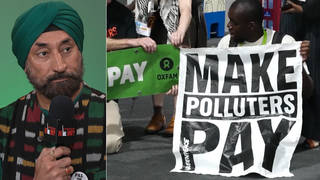
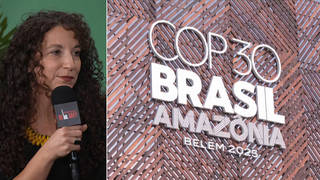





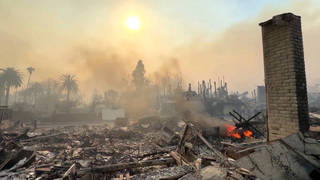
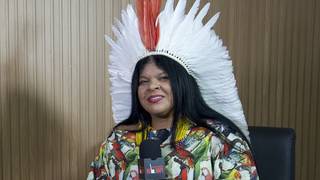
Media Options